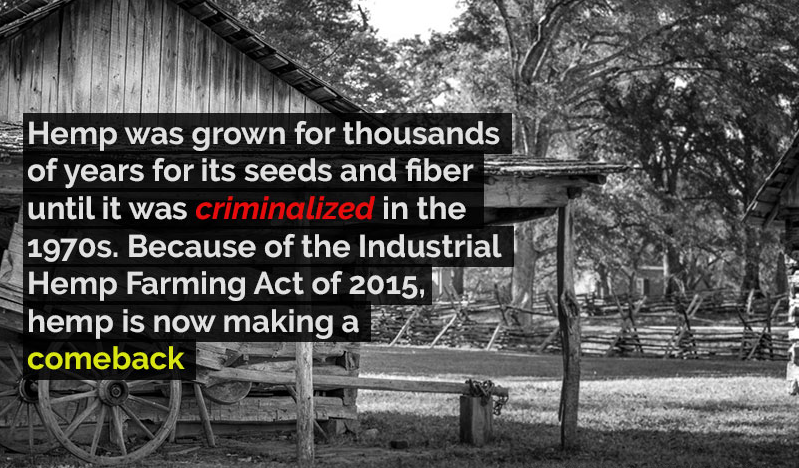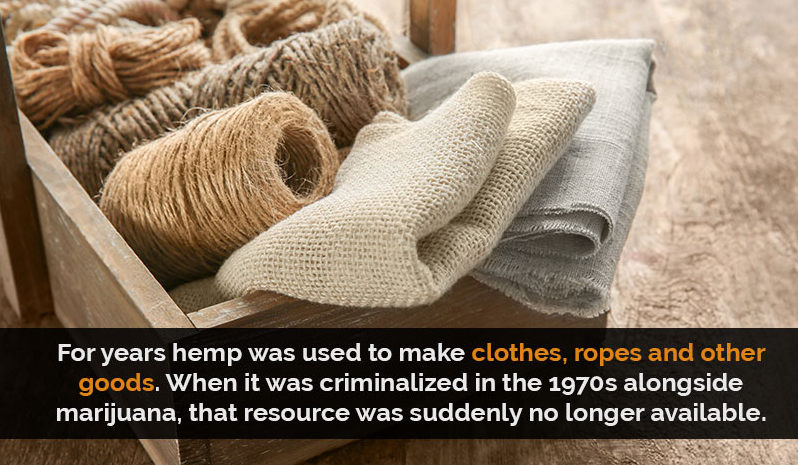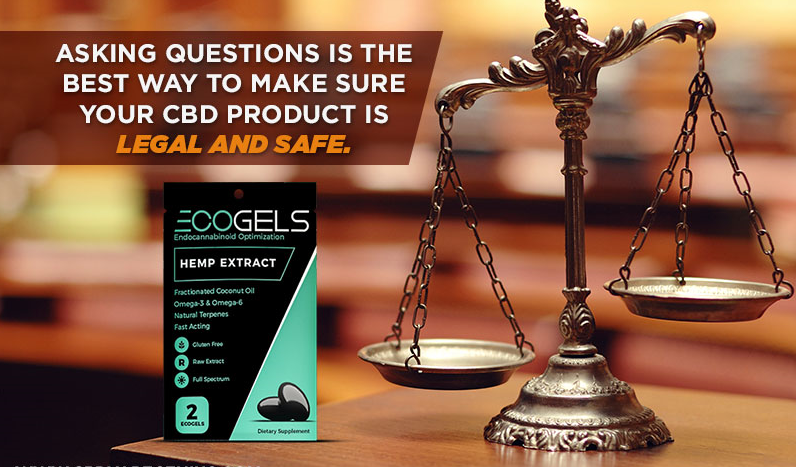What is the legality of hemp? In order to answer this question, we must understand the differences between hemp, marijuana, and CBD.
Hemp may be a different type of cannabis, that should make it illegal too, right? Well, this is where the legality of hemp gets a little tricky.
Cannabidiol, or CBD, is a somewhat mysterious compound. Discovered in the late 1800’s, the cannabis-produced compound has been widely misunderstood for more than a century.
CBD is a cannabinoid produced by members of the cannabis family and offers a long list of health benefits. It is produced in the highest concentration by the hemp plant.
During the early-to-mid 1900’s, CBD was wrongly blamed for the psychoactive effects that its sister compound THC produces. Little research was done on CBD itself, so its true effects stayed shrouded in mystery for several decades.
Because of the mystery behind its effects and the way it interacts with the body, it was made fully illegal (even for medical use) – along with the rest of the plant, in the 1970’s and remained under that status until the 2014 US Farm Bill and the 2015 Industrial Hemp Farming Act which legalized it again for industrial use. This has opened the door for hemp to be grown, but has left much gray area in terms of the legalization of non-industrial products made from it.
Before we get too deep into laws and regulations though, let’s take a step back and clear up a few of the misunderstandings about CBD itself.

Legality of hemp
What is CBD?
As we said before, CBD is a compound produced naturally by different cannabis plants. It is produced by both marijuana and hemp plants, but it is found in the highest concentration in hemp.
For a long time, scientists confused CBD with the high-inducing compound THC. THC causes strong psychoactive effects and can cause negative side effects such as anxiety and memory loss. THC is primarily produced by marijuana. The combination of its mind-altering effects and its potentially dangerous side effects is what led THC-rich marijuana to be outlawed.
THC makes up more than 20% of the cannabinoid compounds that marijuana produces. CBD only makes up 10%. On the other end of the spectrum, THC makes up less than .3% of cannabinoids that hemp produces, while CBD makes up more than 30%. Hemp’s high concentration of CBD vs. THC makes it highly sought-after for those seeking medical relief.
Unlike THC, CBD does not cause any psychoactive effects and has not been linked to any significant side effects. Rather, CBD interacts with different bodily systems to promote healing.
CBD does this by interacting with receptors in the body’s endocannabinoid system. The endocannabinoid system regulates many important bodily functions and scientists believe it is largely responsible for maintaining homeostasis – the body’s optimal level of internal balance.
When CBD interacts with receptors in the endocannabinoid system, it slightly alters the way the system works to provide healing and balance. CBD has been shown to reduce levels of pain and inflammation, reduce the risk of artery blockage, reduce nausea and vomiting, regulate the immune system, suppress muscle spasms and help those suffering from sleep disorders, among other things.
Other cannabinoids besides CBD and THC are also found in cannabis plants. While there are supposedly over 100 in existence, some of the main ones to keep in mind are CBG, CBC and CBN.
The Legality of Hemp and CBD
As stated before, although hemp was widely used as an industrial crop for thousands of years, it was made illegal alongside marijuana in the 1970’s for all purposes, though laws starting in 1937 had been limiting its use drastically already. During that time governments in several countries were cracking down on the abuse of narcotics and other drugs.
At the time, only a small amount of research had been done on the individual cannabinoids found in hemp and their effects on the body. It was assumed that since marijuana caused mind-altering effects, its cousin hemp would as well. Though there was actually plenty of research at the time on cannabis in general leading President Reagan’s own team to advise decriminalization, the subject of cannabis illegalization as a whole was often more about competition with other industries than a lack of medical evidence, and it was completely illegalized in 1970.
This caused a major setback for hemp farmers across the nation. Most had grown the crop for its seeds and its fibrous qualities. For years hemp had been used to make clothes, ropes and other goods. Now, suddenly that resource was no longer available. Finished hemp products were allowed to be shipped into the country from outside producers such as China, but that was expensive and not very economical.

Legality of hemp
For decades those in the hemp industry tried to fight back. Finally, in 2014, the Farm Bill was passed and in 2015, the Industrial Hemp Farming Act was passed. Because of these bills industrial hemp was removed from the list of controlled substances.
This act made it possible for hemp to be grown for research, or by licensed farmers as part of a state’s pilot program. This is where things get a little bit tricky. You see, not just anyone can grow hemp. Farmers have to grow it for research, or under a pilot program and must have a state license. If it is grown outside of either of those two capacities, the legality of hemp may still be considered illegal.
This strict regulation, along with some loose wording in the bills themselves, have caused the DEA and many state authorities and local farmers to butt heads.
Because of the confusion caused by the bill, new legislation is being considered and will be voted on later this year. Amendments to the Industrial Hemp Farming Act, if passed, would legalize hemp across the nation and would allow farmers in every state to begin producing it – regardless of their reason behind its production.
This new legislation would be great for the hemp industry, because federal authority would shift from the DEA to the Department of Agriculture. This would allow hemp products to be more closely regulated to insure that the CBD products on the market are safe and really do contain less than .3% THC.
Legality Of Hemp, Is My Product Legal?
If there are so many regulations in the hemp industry, how do you know that the CBD you are getting is legal? As we said before, legal hemp has to be grown by a licensed farmer for either research or as part of a state’s pilot program and must include less than .3% THC.
Asking questions is the first step to ensuring the products you are receiving are legal. Ask the producer where they get their hemp and CBD concentrate from. Who grows it? Do they have a license? And what state is the product from? Make sure the hemp in your product has been sourced from a state that is running a legal pilot program.
It’s also important to verify the contents of your CBD product. Any legitimate CBD producer will have certified lab results available on their website or on request. Asking for lab results is the best way to ensure the product you are getting doesn’t have any unwanted ingredients.

Legality of hemp
What Products Are Out There?
When CBD is extracted from the hemp plant, it is concentrated into a dense oil. That oil is then mixed with various ingredients to make different products.
CBD products with the best results are usually vapes and tinctures. Vape additives allow the CBD to be absorbed directly into the blood stream through the lungs. This means that users are able to start feeling the vape’s effects almost instantly. Vapes allow up to 40% of the CBD to be absorbed into the body, and can be administered again throughout the day.
Tinctures are usually the favorite of people who suffer from chronic conditions. Tinctures are typically taken sublingually – beneath the tongue – and are absorbed into the bloodstream through the mouth’s mucus membrane. Tinctures allow up to 35% of the CBD to be absorbed into the body. While tinctures are most effective when taken sublingually, the mixture can also be added to tea, coffee or soups.
Edibles and capsules take a little bit longer to take effect than the previous two methods of administration, but they also last a lot longer. There are a wide variety of edible CBD products which range from gummy bears and brownies to energy shots.
For those seeking targeted pain and inflammation relief CBD can also be applied topically with a lotion, salve or cream. These products are great for those suffering from deep muscle and joint pain. They are also good for people wanting to add something to their daily beauty routine.
Of course, be sure to consult your doctor before changing any medical habits.
Where is the Research?
Stating that CBD provides all of these great health benefits is a hefty claim. That’s why we’ve made sure to do our due diligence when researching the topic.
Here are a few articles that show the effectiveness CBD has in treating different illnesses.
In 2004 this study was done by the British Journal of Ophthalmology about the potential healing effects that CBD and other cannabinoids have in treating glaucoma. They do this in part, by reducing the pressure levels in the eyes.
In 2013, another study was done on the clinical applications of CBD in treating neurodegenerative disorders.
In the same year, this study was published in the Rambam Maimonides Medical Journal which details the way CBD and other cannabinoids interact with the endocannabinoid system to sooth acute and chronic pain.
Later in 2015, a study was published in the Neurotherapeutics journal which discusses CBD as a potential treatment for anxiety disorders.
In 2016, a case study was conducted on a girl who suffered from PTSD-related anxiety and insomnia. CBD was shown to significantly reduce the symptoms related to her disorder.
The list of studies showing the effectiveness of CBD in treating various illnesses goes on and on. With hemp now legalized, CBD will probably be researched more and more and will continue to grow as a natural treatment alternate.
Legality of hemp – References
Shannon, S., & Opila-Lehman, J. (2016). Effectiveness of Cannabidiol Oil for Pediatric Anxiety and Insomnia as Part of Posttraumatic Stress Disorder: A Case Report. The Permanente Journal, 20(4), 108–111. http://doi.org/10.7812/TPP/16-005
Zuardi, A.W. (2008). Cannabidiol: from an inactive cannabinoid to a drug with wide spectrum of action. Rev Bras Psiquiatr, 30(3), 271-280. https://www.ncbi.nlm.nih.gov/pubmed/18833429
Blessing, E. M., Steenkamp, M. M., Manzanares, J., & Marmar, C. R. (2015). Cannabidiol as a Potential Treatment for Anxiety Disorders. Neurotherapeutics, 12(4), 825–836. http://doi.org/10.1007/s13311-015-0387-1
Fine, P. G., & Rosenfeld, M. J. (2013). The Endocannabinoid System, Cannabinoids, and Pain. Rambam Maimonides Medical Journal, 4(4), e0022. http://doi.org/10.5041/RMMJ.10129
Fernández-Ruiz, J., Sagredo, O., Pazos, M. R., García, C., Pertwee, R., Mechoulam, R., & Martínez-Orgado, J. (2013). Cannabidiol for neurodegenerative disorders: important new clinical applications for this phytocannabinoid? British Journal of Clinical Pharmacology, 75(2), 323–333. http://doi.org/10.1111/j.1365-2125.2012.04341.x
Tomida, I., Pertwee, R. G., & Azuara-Blanco, A. (2004). Cannabinoids and glaucoma. The British Journal of Ophthalmology, 88(5), 708–713. http://doi.org/10.1136/bjo.2003.032250
Russo, E. B. (2011). Taming THC: potential cannabis synergy and phytocannabinoid-terpenoid entourage effects. British Journal of Pharmacology, 163(7), 1344–1364. http://doi.org/10.1111/j.1476-5381.2011.01238.x
